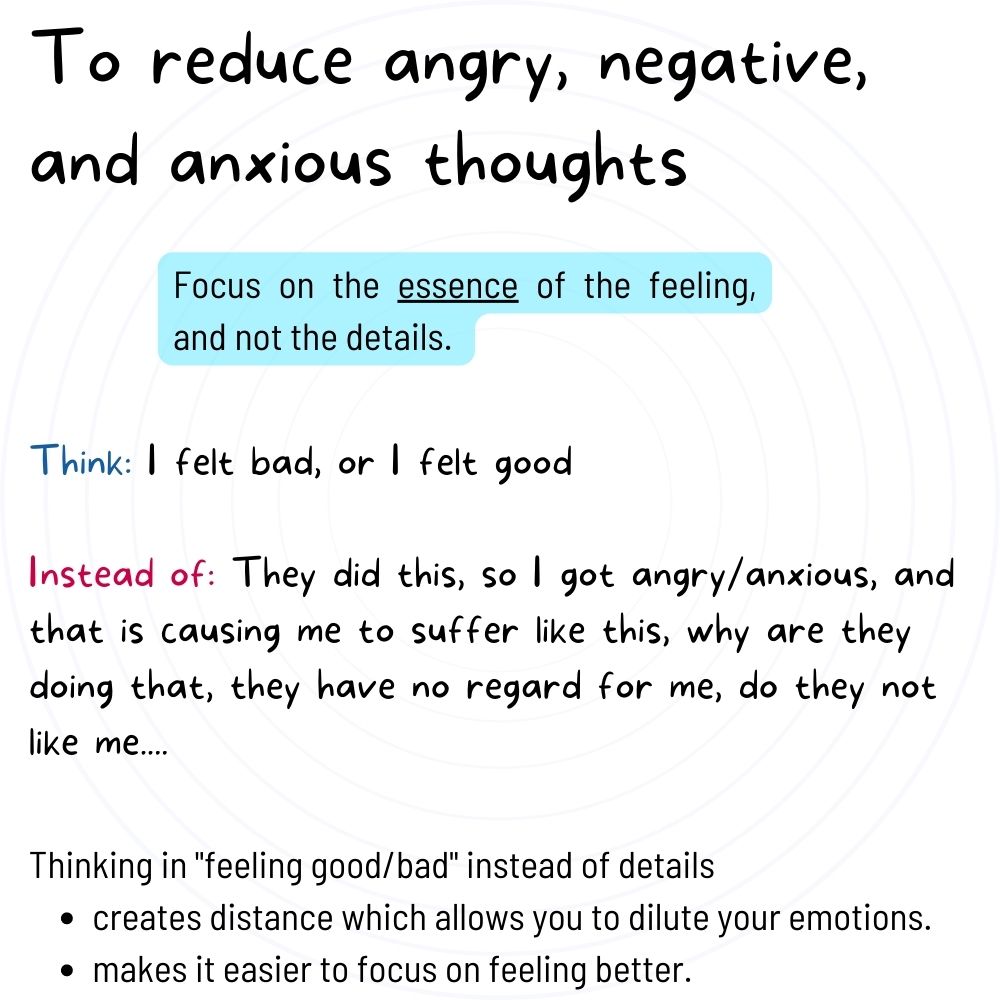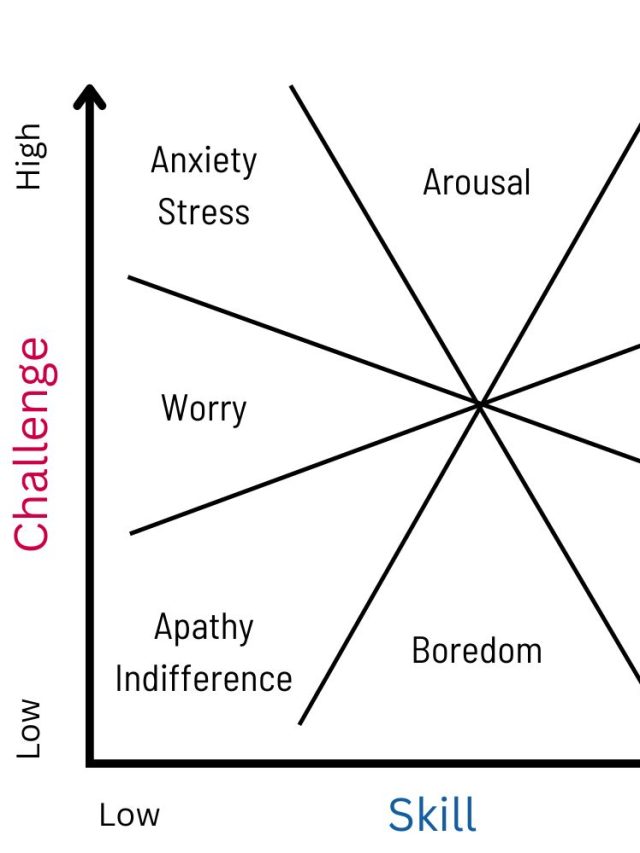Negative thoughts are a part of a healthy mind, but sometimes they spiral out of control. Follow the practical tips in this article to reduce their frequency.

- What are negative intrusive thoughts?
- Are negative thoughts normal?
-
Techniques to manage and reduce negative thoughts and emotions
- 1. Tolerance building
- 2. Mental zooming-out
- 3. 3rd-person self-talk
- 4. Cognitive defusion
- 5. Use distractions to snap out
- 6. Engage in hobbies that occupy attention
- 7. Listen to music while working/habitual routines
- 8. Sensory grounding technique
- 9. Artistic expression of negative thoughts
- 10. Exercise and dance
- 11. Socialize
- 12. Adjust and explore your unmet needs
- 13. Seek cognitive closure
- 14. Think positively
- Strategies to avoid unless recommended by a professional
- Should you suppress negative thoughts?
- Feeling all your feelings isn’t a very good idea because of negativity-prone biases
- We are inclined to have negative thoughts
- Sources
What are negative intrusive thoughts?
Negative thoughts, negative automatic thoughts, or intrusive thoughts contain many negative emotions, details, judgments, and anxiety, and they cause further stress to the person. They are a chain of thoughts that highlight negative information from your memory, negative possibilities in the future, and negative events in your immediate surroundings.
While negative thoughts are perfectly normal for a healthy mind, they are often more pronounced in those with anxiety, depression, and other psychological disorders like OCD. The personality trait “neuroticism” emerges from[1] a tendency to have automatic negative thoughts. People with high sensitivity to threats, like highly sensitive people, are also likely to have more negative thoughts.
Negative thoughts are closely related to low self-esteem, anxiety/worry, lack of confidence, depressive thoughts, and pessimism.
Some negative thoughts are meta-negative thoughts – like anxiety about anxiety or stress about being in a negative situation. These occur during self-reflection.
Are negative thoughts normal?
A healthy mind has a good mixture of positive and negative thoughts. For example, one estimate[2] suggests that those with severe mental health issues have an equal amount of positive and negative self-referential thoughts (I am…), and those who are mentally fit have 1.6 positive thoughts for each negative thought. So an internal dialog could be healthy even if 35% of thoughts are negative. Another estimate[3] puts the positive-to-negative thought ratio at 1.7:1 for functionally healthy people.
Types of negative thoughts
- Cognitive distortions: Cognitive distortions are inaccurate interpretations and judgments that cause stress and anxiety. E.g., Jumping to conclusions, black-and-white thinking, etc. Here’s a list of them.
- Ruminations: Ruminations are thoughts about negative experiences that you keep replaying repeatedly. E.g., “Why was he being mean to me when I did nothing?, But why?, He said this…”
- Worry: Worry is thoughts that focus on negative possibilities that stress you. “Will he return safely from the flight? His phone must be dead?”
- Self-defeating thoughts: Self-defeating thoughts are those which pass judgment. E.g., “I am useless, I can’t… I just can’t.”
- Social anxiety: Thoughts related to others judging you negatively. E.g., “I can’t go out in public, I’ll say something stupid, and they will judge me.”
Negative thoughts are intrusive, meaning they emerge in the middle of other activities, and automatic, meaning you have no control over them.
Techniques to manage and reduce negative thoughts and emotions
Here are some evidence-based techniques to use to manage negative thoughts that are often taught in therapy and have a strong foundation.
1. Tolerance building
When you experience negative thoughts, learn to tolerate them as they are just thoughts and not facts[4]. When you are in a negative mood, build tolerance by committing yourself to let the mood pass. Remind yourself the mood won’t do any damage. Tolerance-building exercises also make people more resilient.
- Use Berking & Whitley’s method: First, bring negative emotions into awareness, don’t suppress them. Instruct yourself to tolerate the emotions. Address the context of these emotions – does it involve low self-esteem, does it involve other people, does it involve a fear of failure, etc.? Tell yourself you are resilient and strong.
- Remind yourself that your negative thoughts are just negative thoughts and not your identity, so they don’t have power over you – you have power over them. This is a core principle in acceptance and commitment therapy, wildly popular for managing the mind.
- Force a behavior change. Emotions, thoughts, and behaviors are all interlinked. If one mechanism changes, the rest change. So if you stick to positive behavior like good habits, you are likely to reduce automatic triggers to overthinking.
2. Mental zooming-out
If you are likely to get into a lot of details, start thinking of emotions in their diluted forms as good or bad: Instead of “I don’t like what he said about XYZ, and it is incorrect to say that,” say, “I felt bad.” Thinking of emotions in their “global” essence, like feeling good or bad, changes the brain’s focus[5] toward a more holistic perspective instead of thinking about the details. It helps you distance yourself. So when you are fixating on the details, move your focus away from them by saying, “I felt bad” or “I felt good.”

3. 3rd-person self-talk
How attached you are to your thoughts affects their emotional impact, so detaching helps. You can change your intrusive thoughts from a first-person perspective to a 3rd person perspective by changing all “I” and “me” statements to “He/she/they statements.” Reword your thoughts as if you are talking about a 3rd person. For example, “I am furious” will change to “he is furious.” This creates psychological distance between you and your thoughts, and because the thoughts move further away (figuratively), they reduce in intensity.
4. Cognitive defusion
Use cognitive defusion techniques to dilute the meaning of disturbing thoughts so they become powerless. Defusion means the meaning of thoughts is un-fused from your self-concept.
4 very effective techniques are:
- Word repetition: Repeat your trigger words very fast for 30 seconds; this makes them lose their power.
- Slo-mo thoughts: Verbally slow down your thoughts so much that they feel silly
- Write your thoughts but focus on something else: You can write/type your thoughts and focus on beautifying your handwriting and speed of writing or typing.
- Diluting behavior: If your negative thoughts are making you do something drastic, minimize the behavior to something around 50% intensity. For example, if your negative thoughts are compelling you to message someone rudely, type it out and then dilute the message into something weaker and softer by 50%.
5. Use distractions to snap out
A temporary distraction can help you cut negative thoughts. Research suggests children[6] and adults[7] benefit from simple distractions to reduce depressive thoughts. Since negative thoughts require attention, giving attention to a more engaging situation takes attention away from negative thoughts. For example, puzzles, self-grooming activities, music, cooking, cleaning, homework, etc., can be effective distractions.
6. Engage in hobbies that occupy attention
Hobbies are a way to engage the mind in an enjoyable and productive way, without the pressure of enjoyment or productivity. For that reason, it is a natural source of positive emotions and satisfaction. Hobbies also reduce the total time available to enter a negative thought pattern. It’s like cutting the source of negative thoughts (an idle mind) before it even begins.
Using music or engaging in hobbies changes the brain’s activity to something that doesn’t trigger negative thoughts.
7. Listen to music while working/habitual routines
Some negative thoughts emerge at random because the mind isn’t occupied and has extra attention to wander around. This state, called mind-wandering, creates thoughts when we are doing a routine that doesn’t need attention or working on boring tasks. In such situations, music can occupy surplus attention and prevent mind-wandering. Like music, background chatter and noisy environments can help too. Those with ADHD can also focus better with light music[8] and noise[9]. So the chance to have negative thoughts related to being distracted or procrastinating reduces in frequency. Simply because the extra uncontrolled attention is occupied.
8. Sensory grounding technique
The sensory grounding technique, popularly called the 5-4-3-2-1 mindfulness technique, is a great way to stop a mental spiral (which could lead to a panic attack) and interrupt thoughts. It forces the brain to reconnect with the reality outside your body instead of diverting all energy to rapid overthinking. The technique goes as follows:
- Notice 5 things you can see
- Notice 4 things you can hear
- Notice 3 things you can touch
- Notice 2 things you can smell
- Notice 1 thing you can taste
9. Artistic expression of negative thoughts
Artistic expression is a source of positive thoughts, and research demonstrates[10] it plays a role in improving well-being. Appreciating beauty and creating art[11] improve mood. Making visual art, music, poetry, pottery, crafts, or even memes reprocess negative thoughts into something more vague and diluted. Making art changes the psychological value of negative thoughts into something that contains beauty, effort, and achievement. Drawing, crafts like collages and origami, visual design, and making music are common ways to express thoughts and feelings as art.
10. Exercise and dance
Exercise[12] and enjoyable movements like dance[13] release endorphins that temporarily improve mood, which reduces negative thoughts. Exercise is also known to restructure an anxious[14] and depressed brain[15] (neuroplasticity) in ways that reduce the chances of negative thoughts. It breaks down neural pathways for previously developed negative thoughts. Studies that see a positive effect of exercise on depression and anxiety typically use a minimum of 30-minute sessions of aerobic or strength exercise routines thrice a week.
11. Socialize
Researchers have demonstrated with brain images[16] that positive social interactions can overpower fear-related memories and weaken them. Similarly, research shows that social support[17] can reduce negative thoughts, anxiety, and fear in humans. Even for those with social anxiety[18], gradual exposure to safe social environments can reduce the impact of social anxiety. This is called graded self-exposure, where you enter the least anxiety-inducing social situations and then get used to entering those that cause more anxiety. Once you are habituated, social anxiety reduces. You can begin with small talk, phone/text conversations, or professional meets to start easy.
12. Adjust and explore your unmet needs
When you realize you are in a negative thought pattern or are overthinking, explore sources of negative emotions like frustration – is it hunger or thirst? is it lack of sleep? is it a bad stomach? is it a headache? is it loneliness? is it a random bit of news you found on social media that’s been bothering you in the background? Answering these questions can highlight your needs, such as food, security, social connection, or a sense of justice. Divert your attention to those to make your negative thoughts more productive and useful.
When needs are unmet, people may experience loosely-related negative thoughts and overthink in ways that take their focus away from their needs.
- Need for defining oneself – identity & self-concept
- Need for removing uncertainty – gaining control & clarity
- Need for meaning and purpose – sense-making & meaning-making for “grand” claims
- Need for validating experiences – need for someone to say they agree or relate, or simply believe what they are thinking
- Need for growth – self-improvement
- Need for improving attitude toward oneself – self-esteem & self-affirmation
- Need for belonging – becoming a part of a tribe or collective
- Need for autonomy – feeling in control & independent
- Need for entitlement – feeling like things should go your way
- Need for security and safety – avoiding threats and protecting those close to you above all else
13. Seek cognitive closure
Many times, people lack cognitive closure[19] – which is a way to answer “the 6 Ws” -why, who, what, when, where, and how. Because they lack answers, they have thoughts like a song stuck in their head that are begging for closure via answers. Some of these thoughts only stop when there is a valid and believable answer. These are instances where people say, “that was bugging me for ages; now I know why XYZ happened.” To resolve your need for closure, explore your thoughts and find out what answers you are seeking. Try to answer them in a positive way. Learn about behavior and social dynamics to understand how things work in life. If you can’t find answers, take a philosophical approach that helps you get past them.
14. Think positively
While it’s a cliche, thinking positively has many benefits. They broaden one’s perspective to accept more positive thoughts and defend against [20]negative thoughts about stressful events. If you can’t reduce negative thoughts, you can add more positive thoughts to maintain a healthy positive-to-negative thought ratio. Purposeful positive thinking also makes positive thoughts more available, which is likely to make your dreams and daydreams more positive than before. One theory of dreaming[21] suggests dreams are a story made out of randomly activated memory traces. When the random memory traces are more positive, the dream story will likely be more positive. And, this will reduce secondary worry about bad dreams.
Laughing[22] and smiling, in particular, are powerful ways to induce a positive mood.
Increase positive thoughts by:
- Appreciating art and beauty
- Expressing gratitude
- Hoping for good social interactions
- Meeting encouraging people
- Participating in fun and thrilling experiences that contain laughter and giggles
Strategies to avoid unless recommended by a professional
- Negative thought journaling: Writing down negative thoughts and reading them or writing them down daily can make them available in your mind more often than necessary. This spoils the mood and perpetuates a negative thinking cycle, which, ironically, you are trying to avoid. Here’s a guide on how to journal your thoughts and what/when/how to write.
- Venting: Venting through aggressive means[23] like yelling and emotional outbursts can amplify the emotions instead of diluting them because you are giving more substance to the emotions through detailed words, actions, sounds, crying, and conversations. Venting on social media also amplifies negative thoughts because algorithms will feed you similar posts, your audience may reward the venting with likes encouraging you to vent more, and your audience may respond similarly.
Should you suppress negative thoughts?
Unless negative thoughts are overwhelming, causing you stress, or interfering with daily functioning, negative thoughts are not a clinical concern but suppressing them has disadvantages.
Suppressing negative thoughts isn’t a wise choice[24]. When we suppress the outward emotional expression of those thoughts, we compromise our cognitive functioning, like decision-making and memory. When negative thoughts are suppressed, they might hog all the mental bandwidth and prevent us from paying attention and prioritizing our adaptation to circumstances. On the other hand, re-appraising negative thoughts that create strong emotions do not compromise our cognitive functioning. Re-appraising means converting and modifying thoughts to mean something different. For example, converting a sense of doom into a problem-solving mindset to overcome difficult hurdles. Keeping your cool or holding back emotional expression[25] can spoil our memory formation during the suppression period and increase physical signs of stress too. This makes self-growth difficult, which reinforces the unhappy state. So instead of suppressing negative thoughts, convert them to mean something more positive or useful.
Feeling all your feelings isn’t a very good idea because of negativity-prone biases
An unhealthy belief about regularly expressing all your thoughts and emotions is a problem because of the availability bias. When you constantly keep your feelings at the center, constantly talk about them, or always “feel your feelings,” you populate your mind with associated negative thoughts. You strengthen the memory and availability of negative thoughts, making them more likely to occur. This defeats the purpose. Instead, you rework your thoughts or extinguish their triggers. Feelings are imprecise entities that can very strongly misguide you because it’s hard to find the true source of a feeling. Humans typically get feelings and then build a story to justify them via a process called sense-making. This is an opportunity to misguide yourself. For example, your negative thoughts could emerge from hunger or pain, but you may use that emotion to interpret a very mildly annoying conversation as strong negativity.
We are inclined to have negative thoughts
Negative thoughts are a normal aspect of a healthy human brain, and we are naturally inclined to have negative thoughts because of inherent biases in perception that help us stay alive.
Negativity bias
Humans have evolved an attention system that prioritizes negative information because it is more relevant to safety. It is also prone to evaluate ambiguous circumstances more negatively than positively, because the cost of not identifying threats in the environment could be high (and sometimes fatal). So we may notice more negative news and remember more negative events in a relationship, which perpetuates the negative thinking cycle. This bias also makes negative information more memorable.
Loss aversion
Humans exhibit loss aversion, a tendency to value loss more than an equivalent gain. For example, the pain of losing $100 is more pronounced than the joy of finding $100.
Availability bias
In everyday life, we do not access all information that we have ever learned and experienced. We base our decisions and judgments on what’s readily available and easily remembered (tends to be negative because of the negativity bias). This becomes a problem when more negative details are available in mind. Those negative details make us more likely to process other negative details, creating a feedback loop of negative thoughts.
Sources
[2]: https://link.springer.com/article/10.1007/BF01176069
[3]: https://www.researchgate.net/publication/226389616_The_internal_dialogue_On_the_asymmetry_between_positive_and_negative_coping_thoughts
[4]: https://d1wqtxts1xzle7.cloudfront.net/75156748/A_review_of_Acceptance_and_Commitment_Th20211125-26710-4ytylr.pdf
[5]: https://www.ncbi.nlm.nih.gov/pmc/articles/PMC3153425/
[6]: https://link.springer.com/article/10.1007/s10608-019-10073-4
[7]: https://bpspsychub.onlinelibrary.wiley.com/doi/abs/10.1111/j.2044-8260.1984.tb00628.x
[8]: https://measuringbehavior.org/files/ProceedingsPDF(website)/Chew_Symposium2.10.pdf
[9]: https://acamh.onlinelibrary.wiley.com/doi/10.1111/j.1469-7610.2007.01749.x
[10]: https://www.tandfonline.com/doi/full/10.3109/09638288.2012.732188?src=recsys
[11]: https://www.tandfonline.com/doi/abs/10.1080/07421656.2005.10129521
[12]: https://link.springer.com/article/10.2165/00007256-199724010-00002
[13]: https://link.springer.com/article/10.1007/s40750-017-0067-y
[14]: https://www.ncbi.nlm.nih.gov/pmc/articles/PMC3632802/
[15]: https://www.ncbi.nlm.nih.gov/pmc/articles/PMC7415205/
[16]: https://directorsblog.nih.gov/2022/08/02/seeing-two-memories-at-once/
[17]: https://onlinelibrary.wiley.com/doi/abs/10.1046/j.1365-2648.1997.1997025095.x
[18]: https://www.sciencedirect.com/science/article/abs/pii/S0005789405800401
[19]: https://psycnet.apa.org/record/1995-07984-001
[20]: https://digitalcommons.memphis.edu/facpubs/10130/
[21]: https://europepmc.org/article/med/21570
[22]: https://cdr.lib.unc.edu/concern/honors_theses/hd76s403h
[23]: https://journals.sagepub.com/doi/10.1177/0146167202289002
[24]: https://journals.sagepub.com/doi/10.1111/j.0963-7214.2004.00291.x?icid=int.sj-challenge-page.similar-articles.2
[25]: https://journals.sagepub.com/doi/10.1177/01461672992511010

Hey! Thank you for reading; hope you enjoyed the article. I run Cognition Today to paint a holistic picture of psychology. My content here is referenced and featured in NY Times, Forbes, CNET, Entrepreneur, Lifehacker, about 15 books, academic courses, and 100s of research papers.
I’m a full-time psychology SME consultant and I work part-time with Myelin, an EdTech company. I’m also currently an overtime impostor in the AI industry. I’m attempting (mostly failing) to solve AI’s contextual awareness problem from the cognitive perspective.
I’ve studied at NIMHANS Bangalore (positive psychology), Savitribai Phule Pune University (clinical psychology), Fergusson College (BA psych), and affiliated with IIM Ahmedabad (marketing psychology).
I’m based in Pune, India. Love Sci-fi, horror media; Love rock, metal, synthwave, and K-pop music; can’t whistle; can play 2 guitars at a time.










